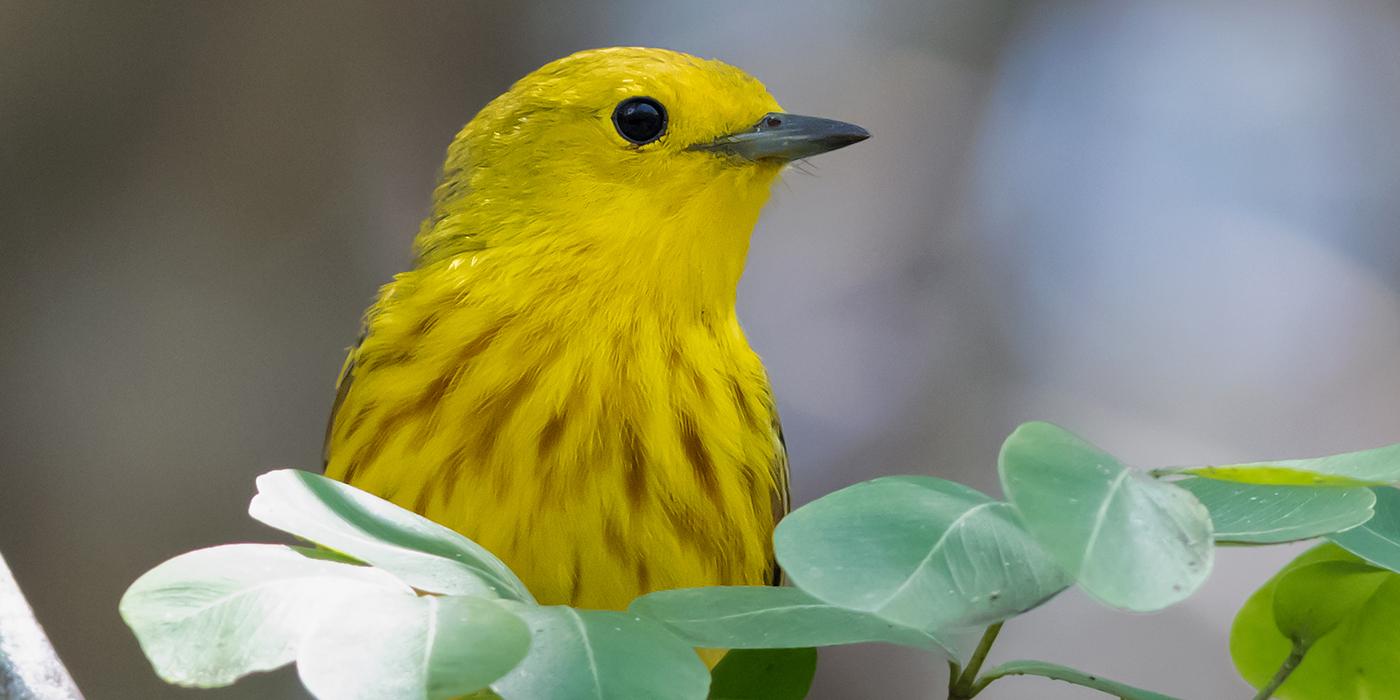Physical Description
Both male and female American yellow warblers are yellow with black eyes. Their wings and backs are yellow-green or yellow-gray while the rest of their body is a brighter yellow. Males have chestnut or brown-red streaks on their chests while females are mostly plain. They have rounded heads and relatively large, stout bills.
American yellow warblers, also called Northern yellow warblers, look mostly the same throughout continental North America. However, the various subspecies that do not migrate north look different. Mangrove yellow warblers’ faces are chestnut-colored, and their back feathers are more green than yellow. Golden yellow warblers have a dark, chestnut or red-brown streak on their head going from their beak to back, and their chest streaks are more pronounced.
Size
Yellow warblers are around 5 inches (12.7 centimeters) long with a 6.5-to-8-inch (16-to-20-centimeter) wingspan. They weigh less than half an ounce, or between 9 and 11 grams.
Native Habitat
American yellow warblers are one of the most widely distributed warblers on their nesting and breeding grounds in North America. They migrate north each spring to nest in temperate, young forests and shrublands from the Arctic Circle to Mexico. When autumn approaches, they fly south to Central and South America, where they primarily winter in mangrove forests. Other subspecies of yellow warbler live in the southern regions year-round.
Lifespan
Yellow warblers can live up to 9 years in the wild.
Communication
Male yellow warblers perch high in tall shrubs or small trees and whistle a “sweet, sweet, sweet, I’m so sweet” sounding song. These notes can be repeated up to ten times a minute.
Both male and female American yellow warblers will make a repeated “seet” sound when they spot a brown-headed cowbird nearby. Cowbirds are notorious for being nest parasites. They replace at least one of the residents’ eggs in the nest with their eggs and then leave their chicks to be raised by the resident female. At the sound of the alert call, female warblers will rush back to their nests and protect their eggs. Other birds, particularly red-winged blackbirds, are also at risk of cowbirds invading their nest and have seemed to learn the warblers’ warning call too.
Food/Eating Habits
Yellow warblers forge at the tops of shrubs and small trees, where they dart quickly among the branches in search of their prey. They primarily eat insects, with caterpillars and other insect larvae making up a large part of their diet. In the winter, they will also eat some fruit.
Social Structure
Upon arriving to their breeding grounds, male yellow warblers are quick to claim their territory and begin defending it from other warblers. Pairs are usually monogamous and may last more than one season in some areas. During the winter, these birds live on their own, establish and defend their feeding territories by themselves.
Reproduction and Development
Male yellow warblers attend to and guard their mate while she builds the nest and incubates their eggs. Females take about four days to build their cup-shaped nests. The nests are made from grasses, bark and nettles, which are then covered on the exterior with spiderwebs and plant fibers. The interior is lined with feathers, animal fur and flowering plant fibers, like cottonwood and dandelion.
Yellow warblers lay an average of four to five eggs in each nest. Female warblers can recognize eggs that are not their own in their nest. In response, they will build a new nest on top of all the eggs. Persistent brown-headed cowbirds may cause a yellow warbler to layer her nest and re-lay her eggs up to six times in a season.
Helpless, light-gray chicks hatch after an 11 to 12-day incubation period. Yellow warbler chicks weigh about 1.5 grams (0.05 ounces). They fledge between 9 and 12 days old. Some fledglings will follow their mother while others go with their father.
Conservation Efforts
While one of the most numerous warblers in North America, the American yellow warblers’ population has declined by 10% over the last decade. One of the yellow warblers’ largest threats is habitat loss and fragmentation. Fragmented habitats have higher rates of brown-headed cowbirds successfully infiltrating the yellow warblers’ nests. Cowbird chicks are larger than yellow warbler chicks, so the cowbirds will often outcompete their nest mates for food.
Since yellow warblers migrate at night, light pollution is a problem. Artificial lights confuse the birds and cause them to collide with tall, lit structures and buildings.
Help this Species
Be a smart consumer. Choose products made with sustainable ingredients, such as Smithsonian certified Bird Friendly coffees, which support farmers striving to limit their impact on wildlife and habitat.
Be a responsible cat owner, and keep cats indoors or under restraint when outside. Never release animals that have been kept as pets into the wild.
Conservation starts with you! Join a citizen science project where you can help collect valuable data for scientists. Encourage your friends and family to get involved too.
Plant native flowers in your garden to help feed resident and migrating pollinators. You'll make your lawn beautiful and help wildlife at the same time!
Smithsonian's National Zoo and Conservation Biology Institute. (n.d.). American yellow warbler. Retrieved January 7, 2026, from https://nationalzoo.si.edu/animals/american-yellow-warbler
Animal News



